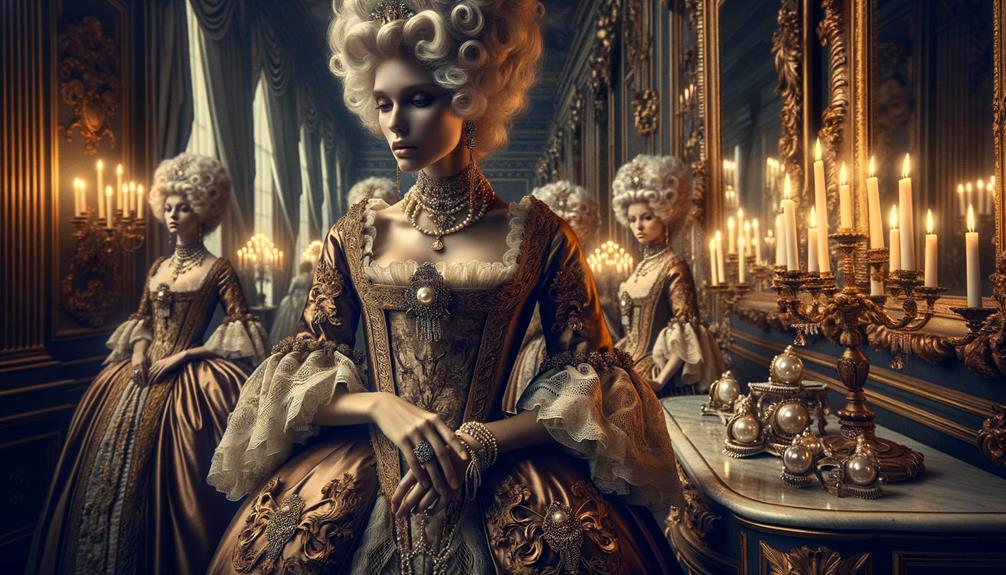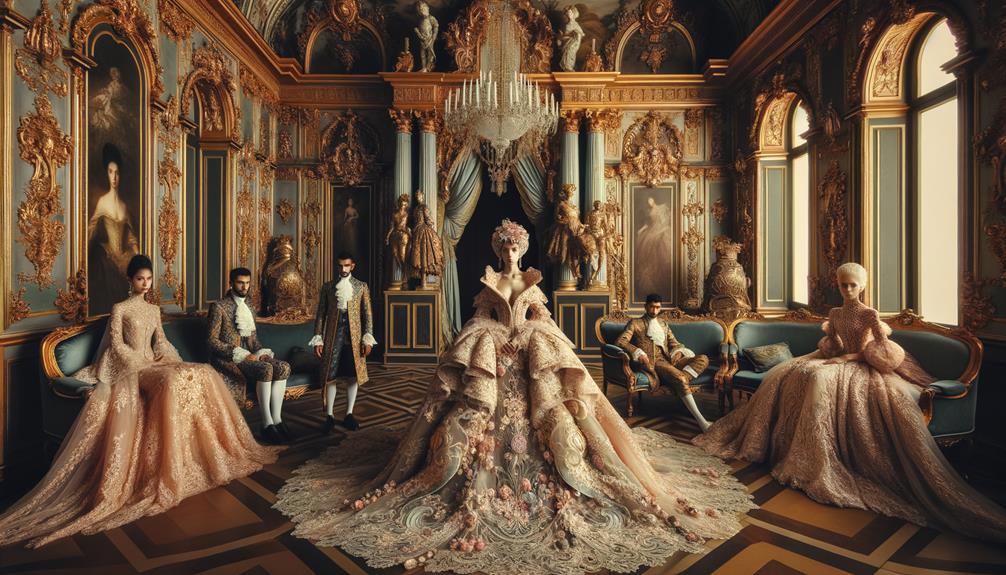Baroque stomachers have long captivated me with their ornate beauty. These triangular bodice pieces were staples in women's wardrobes from the 16th to 18th centuries, adorning open-front bodices. Crafted from luxurious fabrics like silk and satin, they were often embroidered with metallic lace and jewels, showcasing wealth and sophistication. Stomachers were more than just fashion – they were a reflection of social status and refinement. The vibrant hues and intricate patterns added depth and elegance to the wearer's silhouette. Even today, designers like Dior continue to draw inspiration from the stomacher's iconic elongated shape, blending the past and present through these enduring sartorial elements. Exploring stomachers offers a glimpse into the art and history woven into these captivating garments.
Historical Context
During the 16th to 18th centuries, stomachers were a crucial part of women's fashion. They were an essential component of open-front bodices, often heavily embroidered and highly decorated. The triangular shape fit perfectly over the boned stays, adding elegance to the cone-shaped silhouette.
Stomachers featured intricate designs, blooming with vibrant flowers. They were crafted to catch the eye, reflecting the opulence of Baroque fashion. The embroidery often combined metallic lace and jewels, creating a rich texture that complemented the delicate linen collar and chemise underneath.
Maintaining a collection of stomachers allowed for versatile styling. Women could keep several, switching them out for different occasions, matching or contrasting them with the gown. This practice gave them a degree of personal expression within the otherwise rigid fashion of the time.
The decline of stomachers by the late 18th century marked a shift in fashion. The rise of the Regency silhouette and closed-front gowns rendered them obsolete. Yet, the innovation and craftsmanship of these stomachers remain an enduring record of a period where fashion was both an art and a statement.
Design and Materials
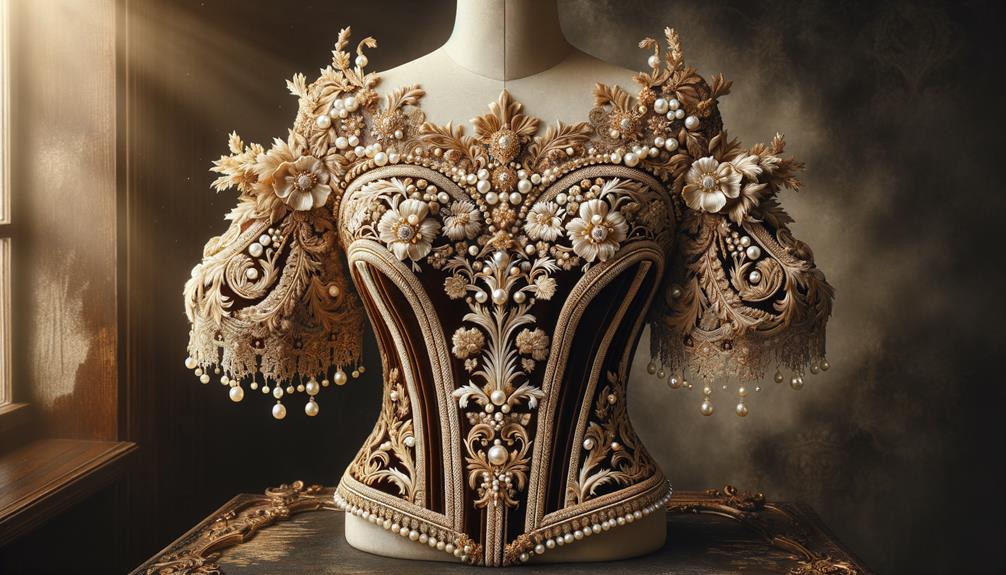
The intricate embroidery and lavish fabrics of stomachers not only added visual splendor but also signaled the wearer's social status. Each one was a canvas, showcasing exquisite artistry through rich materials like silk, velvet, and satin. Contrasting patterns in vibrant hues like blue were often used to create depth.
Heavily embroidered stomachers with floral designs and geometric motifs became a statement piece. The embroidery work, executed in colored silks and metallic threads, depicted a world of opulence. Decorative brooches remained popular, adding dimension and shine to the richly decorated garment.
The contrasting patterns were not just for aesthetics but also a marker of status. The triangular shape, often reinforced with rigid boning, gave a dramatic, elongated silhouette. This structural element was as much about form as it was about highlighting the luxurious materials used.
Every detail mattered. The stomachers, with their intricate embroidery, were more than just clothing; they were an embodiment of wealth and refinement. Whether through a burst of blue or the delicate shimmer of metallic threads, these pieces showcased the artistry and craftsmanship of the Baroque era.
Embellishment Techniques
Elaborate embroidery, metallic lace, and vibrant jewels transformed stomachers into stunning examples of Baroque fashion. Each touch of embroidered velvet or intricate blackwork added layers of complexity. These intricate details weren't just decorations; they held meaning.
The polychrome floral designs, bursting with color, brought the fabric to life. The shimmering metallic lace, catching the candlelight, added an opulent flair. Jewels and beading created a tactile richness, reflecting light and adding depth.
Contrasting patterns between the stomacher and the gown created a visual dialogue, catching the eye. Faux lacing, often paired with frilly bows, added whimsical touches, blending functionality with style.
The luxurious and plush embroidered velvet offered a canvas for intricate designs. The geometric precision of blackwork embroidery brought a timeless elegance. The vibrant floral motifs celebrated nature's beauty.
These techniques elevated the stomacher to an art form. The careful placement of each element was deliberate, creating a cohesive and striking effect. The artistry spoke of innovation, each piece a record of the craft's evolution.
Social and Cultural Significance
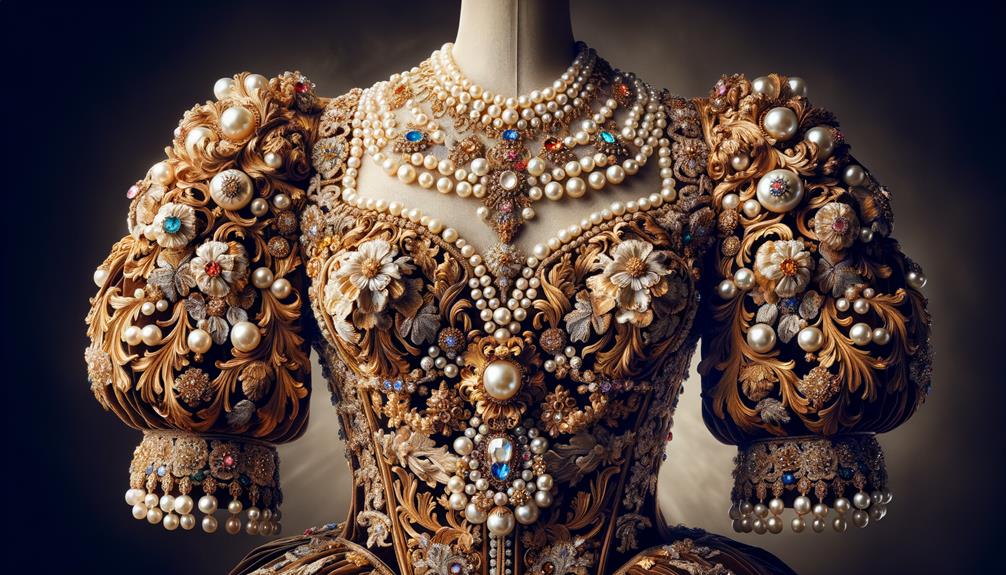
Stomachers, with their intricate designs, were more than just fashion accessories; they were a clear indication of one's social standing and wealth. Wealthy ladies adorned their bodices with stomachers, transforming them into displays of opulence. Embroidered with colored silks, jewels, and metallic lace, these pieces became an essential part of a lady's attire, including her stays and chemise. The intricate work on a stomacher signaled its owner's position within the upper class.
Maria Josefa de Lorena, captured in the portraits of Anton Raphael Mengs, exemplified this. Her stomachers, with their open fronts, showcased the height of sophistication and status. Each stitch and gem spoke volumes about her rank and refinement. The stays and chemise provided the structure, but the stomacher was the decoration that set her apart.
In this context, stomachers weren't mere decoration; they were statements. They revealed the societal layers, where the more elaborate the stomacher, the higher the rank. As society evolved, so did the silhouette, shifting towards more natural forms, but the significance of these bodices in marking wealth and status remains an important chapter in fashion history.
Variations and Styles
Examining the variations and styles of stomachers reveals an intriguing evolution. In the 18th century, the designs shifted from longer, triangular shapes to more streamlined forms. This change was marked by increasing sophistication in decorative elements and materials. The embroidery became more intricate, with metallic lace adding a touch of opulence. Contrasting colors and patterns played a crucial role in creating visual interest, ensuring each piece was unique.
Stomachers were created both boned and unboned, each offering a distinct silhouette. The boned versions provided structure and support, creating a more rigid, angular appearance. The unboned styles, on the other hand, allowed for a softer, more rounded look. Decorative features also evolved, with lace ruffles and faux buttons becoming fashionable choices.
Some notable variations include:
- Triangular Shapes: Early stomachers featured elongated triangular designs, emphasizing the waist.
- Lace Ruffles: By the 18th century, lace ruffles added texture and sophistication.
- Faux Buttons: Decorative faux buttons provided a playful, yet elegant touch.
This blend of structure and embellishment highlights the innovation within historical fashion, reflecting a balance between form and decoration, structure, and softness.
Influence on Modern Fashion
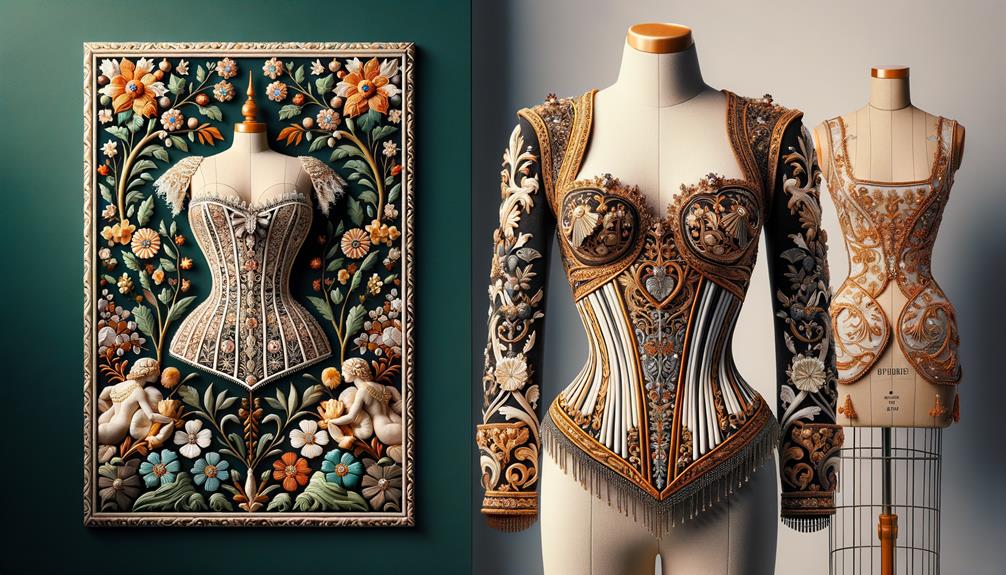
Modern fashion designers like Aquilano Rimondi and Christian Dior have drawn inspiration from the historical stomacher. Their collections feature the same elongated, triangular shapes and intricate detailing as the stomacher. It's clear that the structured, pointed bodices of the past continue to influence both runway and street style today.
Contemporary Design Inspirations
In modern fashion, designers skillfully blend historical elements like the stomacher into contemporary designs, bridging the past and present. Aquilano Rimondi's Fall 2012 collection showcased elongated, triangular shapes reminiscent of Renaissance and Rococo stomachers, decorated with intricate embellishments that connected centuries. Christian Dior's Fall 2014 Couture line went further, featuring structured, pointed bodices echoing the traditional stomacher's visual effect.
These historical costume-inspired designs highlight the enduring influence of 16th-18th century garments on modern silhouettes. Fashion thrives on innovation, yet it often looks to the past for creative inspiration. The stomacher, with its intricate details and bold shapes, offers a rich source of inspiration.
Designers like Rimondi and Dior seamlessly integrate historical elements into contemporary apparel, enriching our understanding of fashion's evolution. This can be seen in:
- Elongated, Triangular Shapes: Reflecting Renaissance and Rococo aesthetics.
- Decorative Embellishments: Bringing historical elegance into modern wear.
- Structured Bodices: Evoking the iconic stomacher's form and function.
These elements aren't just nostalgic nods; they demonstrate the enduring appeal of historical design in today's fashion landscape.
Runway and Street Style
On the runway and the streets, fashion draws inspiration from historical elements like the stomacher, infusing modern designs with a timeless elegance. Aquilano Rimondi's Fall 2012 collection, with its elongated triangular shapes, pays homage to the ornate attire of figures like Maria Josefa de. These shapes, reminiscent of the stomacher, echo through contemporary designs, maintaining a dialogue with the past.
Christian Dior's Fall 2014 Couture line further illustrates this connection. The structured, pointed bodices evoke the visual effect found in Renaissance portraiture. Such designs speak to an enduring fascination with historical styles, reinterpreted for today's silhouettes.
On the streets, I observe this influence subtly woven into modern attire. Elongated lines and decorative details on everyday wear remind me of bygone eras, like the time of King George V and the paintings of Donat. These elements from the Victoria and Albert collection, though centuries old, find new life in the hands of contemporary designers.
The stomacher's legacy lives on, not as mere costume, but as a cornerstone of innovation. It's this blend of history and modernity that continues to inspire and redefine fashion.
Frequently Asked Questions
What Is the Difference Between a Bodice and a Stomacher?
The main difference between a bodice and a stomacher lies in their purpose and appearance. A bodice is the central part of a dress that covers the torso. It's the primary structure that gives the upper portion of the garment its shape and support.
In contrast, a stomacher is a separate, often ornately decorated piece that attaches to the bodice. It serves a decorative function, adding visual interest and sometimes even structural reinforcement to the bodice. Stomechers were particularly popular in historical fashion, where they were used to create a distinct, stylized silhouette.
What Was the Purpose of Stomacher?
The stomacher was a decorative panel that extended the corset's support, making the torso appear longer and more refined. It also served as a canvas for intricate embroidery, adding an artistic touch to the outfit.
How Was a Stomacher Worn?
A stomacher was a decorative panel worn at the front of a woman's bodice during the 16th and 17th centuries. It was pinned or tied to the bodice, covering the gap between the two sides of the garment. The stomacher was often embroidered or adorned with jewels, helping to elongate the torso and enhance the wearer's silhouette.
What Is Elizabethan Stomacher?
During the Elizabethan era, women often wore a distinctive triangular panel called a stomacher that was inserted into the bodice of their dresses. This stiff, ornate piece extended from the bust down to the waist, creating a elongated torso appearance. The stomachers were typically embroidered with intricate designs, serving as a symbol of status and elegance that defined the fashion of the time.
Conclusion
The stomacher's intricate beauty and historical significance are truly captivating. Each delicate bead and stitch tells a story of elegance and the artistry of the past. The Baroque bodice is more than just a fashion statement; it's a testament to human creativity. Seeing its influence in modern designs evokes a deep connection to the cultural tapestry that has been woven over time. This timeless piece reminds us that beauty transcends eras, linking us to a shared identity rooted in art and tradition.



